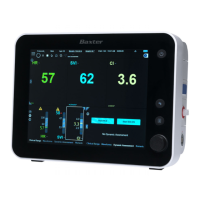5-6 Starling Monitor - User Guide
Patient Preparation
Attaching Starling Sensors
To Attach Starling Sensors to the Patient
1. Ensure the Starling Patient Cable is connected to the Starling Monitor.
Refer to Connecting the Starling Patient Cable on page 4-10.
2. Make sure the skin area has been properly prepared, as previously described.
3. Check the Starling Sensor Set for expiration date and make sure the pack is not damaged.
Note
The shelf life of
Starling
Sensors (dependent on the batch) is indicated on the packaging.
Both batch and shelf life will always be shown on the external pouch.
WARNING
Starling Sensors are supplied for single use only.
When using Starling Sensors, users should always observe the following precautions:
Use Starling Sensors only with a Starling Monitor.
Do not use after expiration date.
Replace Starling Sensors with a new set of Sensors after 48 hours of use.
After placement of Starling Sensors, perform a Recalibration of the Sensors (accessed from the
Main Menu (Session Controls & Settings
- see Table 3-1 on page 3-6). Then repeat, once per day.
In the unlikely event that the patient has an allergic reaction to the Starling Sensors, detach the
sensors immediately from the patient and avoid any further placement of Starling Sensors on
this patient.
Starling Sensors should be positioned around the heart. The exact location is flexible, as follows:
Upper sensors may be positioned on the upper chest, shoulders, upper back or axillary region as
long as they are above the heart.
Lower sensors may be positioned on the lower ribs, flanks or back and should be below the heart.
Symmetrical right-left placement of the sensors is preferred when possible, but is not mandatory.
Asymmetrical positioning is permissible.
In adults, lower sensors should be at or above the iliac crest/waist.

